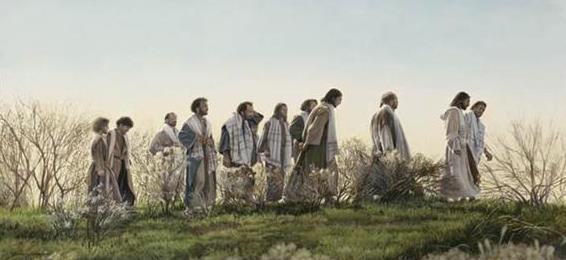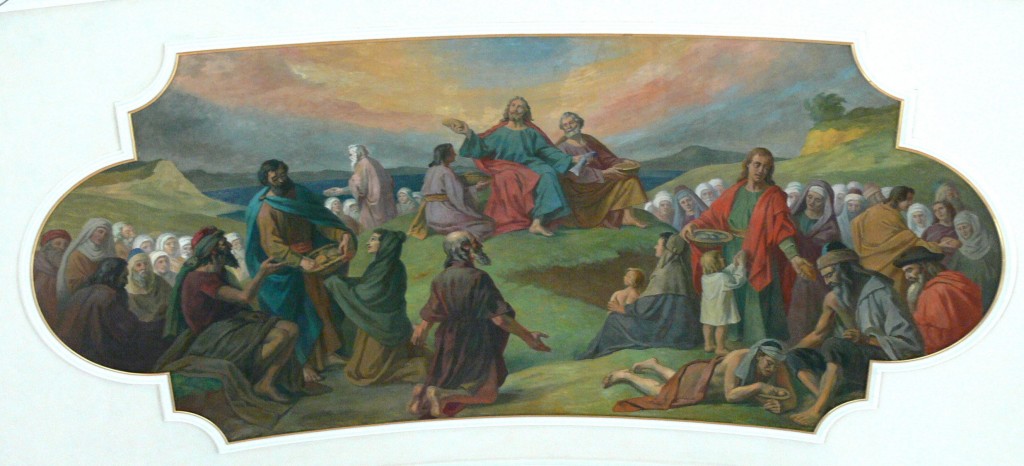Here is part 5 of an 8-part essay by Dr. Gary Deddo titled “The Christian life and our participation in Christ’s continuing ministry.” To read other parts, click on a number: 1, 2, 3, 4, 6, 7, 8. For all 8 parts combined in one article, click here.

Recap of part 4
In part 4 we saw how union with Christ is a way of talking about our core identity in terms of our meaning, significance, security, dignity and destiny. This identity is both a gift given, and a settled fact. Because Jesus is alive—still fully and really human as one of us—and because he continues to minister by his Spirit on the basis of his accomplished work, we are able to participate and have fellowship and communion with him in everything we do. But what does our participation with Jesus in his continuing ministry look like? The New Testament gives several examples. Here in part 5 we’ll look at one of them in depth.
Going against the grain
Though we can live in denial, hiding the truth by attempting to depart from Christ, doing so cannot undo the truth of who we actually are in Christ. We may get splinters, but we cannot change the grain of the wood when we go against it. The only choice we really have is 1) to affirm the reality with our minds and in our actions, or 2) deny the reality of who Christ is and who we are in relationship to him.
In seeking to honor Christ in their actions, some ask, What would Jesus do? But a better question, if we want to truly participate with Christ, is this: What is Jesus doing? Answering this question leads us to seek to discover what Jesus is doing in the present situation and consider how we can get involved with his activity. When we see the depth of the grace of God in uniting us to Christ to share with us his communion with the Father, what else can we possibly do with our lives except to go where he goes, do what he does, and live for the glory of the Father as he always has and still is doing?
What does participation look like? Jesus and feeding the 5,000
The story told in Mark 6:30-44 illustrates how our union with Christ and our participation in his ministry are held together. As it begins, Jesus took some unanticipated initiative. He told the disciples that they should feed these 5,000 people. They’d been listening to the teachings of Jesus until very late that afternoon. There was, perhaps, just enough time to get home by nightfall to prepare supper. So the disciples were astounded at Jesus’ suggestion. How could they possibly feed so many? They didn’t have two years’ worth of wages in their wallets to buy bread, and they certainly didn’t have a chain of bakeries ready to deliver truckloads of it.
Jesus had asked them to do the impossible. But Jesus was not stymied by their incredulity. He had another word for them: “How many loaves do you have? Go and see.” I’m sure the disciples must have wondered at the relevance of such a request. But it got worse. The results of their count yielded only five loaves and just two fish. The disciples did not know what to do next.

(used with permission via Wikimedia Commons)
Jesus provided some leadership. He directed the disciples to get all the people to sit down in groups. The people actually did what the disciples asked, though it would not have been clear what would follow. Some must have muttered, “It’s getting a little late, isn’t it? I thought he was finished.” Next, Jesus took from them the loaves and fish. He looked up to heaven, directing his gaze and his words of thanksgiving for the food to his heavenly Father, for what was going to take place not only would involve Jesus and his disciples but also Jesus with his Father. He broke the fish and loaves in pieces to distribute to the twelve standing around him.
Then the disciples were called back into action. Jesus directed them to hand out the food to the people. I suspect that the people followed the example of the disciples and broke off pieces to give to those next to them. Almost without realizing (Mark here is so understated!), “they all ate and were filled.” Not only that, but from those five loaves and two fish, there were twelve baskets full of broken pieces of bread and fish leftover! Twelve baskets—one for each of the disciples. Can you imagine their reaction as each one brought back a basket full after handing out just a few scraps?
How did this happen? We could simply say Jesus performed a miracle. Of course, but how did he go about it? Was it with great fanfare, a spectacular Hollywood magic show complete with light, mirrors and smoke by which the amazing Jesus impressed us again with his phenomenal powers? Not at all. Jesus did not multiply the loaves and fish by himself. In fact, he drew very little attention to himself. In lifting the food to heaven and saying a blessing, Jesus understood himself as dependent on his Father. This situation was like all the others he encountered in his earthly life: Jesus only did what he saw his Father doing (John 5:19).
Jesus participated in the actions of his Father. Further, Jesus had said to the disciples, “You feed them,” and they did. Jesus (with his Father) not only could have provided the loaves and fishes, but he could have had the disciples stand back, saying “Watch this, boys!” and sent those loaves and fishes flying instantly right into the laps of all 5,000. What an amazing magical moment that would have been! But he didn’t go about it that way at all. He involved his disciples. They participated with him in feeding the hungry.
I am not suggesting that Jesus needed the disciples—or even their fish and loaves. That would be a gross misrepresentation of the truth. But rather, Jesus delighted to find ways for his disciples to get involved in the very things he and his Father were doing. Did these disciples have the understanding or the resources needed for the task? Not at all. But Jesus found a wonderful way for them to participate in his humble exhibition of the divine compassion of his heavenly Father. The disciples got to be involved in the very thing Jesus (and his Father) was doing. I’m sure they were astounded—not just that all the people got fed, but that he took what was theirs, made it his own, and then gave it back to them to serve the people in his name. Can you imagine the joy and wonder of being involved in God’s feeding of 5,000?
Partnership with Christ
This Gospel story illustrates Christian life and ministry. What is needed, good and right, is always overwhelming, even seemingly impossible. We hear a word from Jesus that sounds like “You feed them,” and we quickly become aware that we have so little. It’s humiliating, at least to our pride, to admit how meager our resources are compared to the compassionate aims of God. At that point the question becomes, Will we act in faith, trusting in the character of the one calling for our action and obedience? Will we give him what we have so we can see what he will do with what little we really offer to him?
We may offer to him our failures and our sin in confession, or offer our resources, action plans and obedience with thanksgiving. Will we trust him to do with our meager action just as he did with those first disciples? Will we marvel at the miracle of participating in Christ’s own obedience to the Father in his continuing ministry to his neighbors and his world? That’s the wonder of Christ’s Lordship—he always makes room for our participation, though we never really have what it takes. It is only in partnership with him, in fellowship and communion, in union with him, that we reflect the glory of God as his children.



Dr. Deddo, Thank you for writing “The Christian life and our participation in Christ’s continuing ministry.” Just finished reading part 5. Here’s inspiration to trust Christ to “do with our meager action as he did with the first disciples” in the parable of the feeding of the 5000. Again, thank you.
Thank you Dr Deddo; I have just gone through Part 5 of these series. This is quite an insight! Now I know that with our willingness to participate in Him, Jesus can work with us to be the “light”and “salt” in the world.